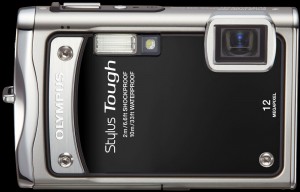Photography around ice and water
Posted by Greg on February 19, 2012Q: How hard is it to paddle around with a camera in the cold? I’d love to do a shoot somewhere with the ice and water. Some of your pictures are amazing. — Donna.
A: Donna, Thanks for the complement. All of the kayaking images that I have taken in the last few years have been with the new breed of “waterproof/shockproof” point and shoot digital cameras. These cameras don’t offer quite the image sharpness and features of more “professional” cameras, but their strength is that you can grab them in an instant and capture images that would go missed with a much bulkier camera or a camera that must be retrieved from a dry box. Most of the images for my Sea Kayaker magazine articles were taken with a waterproof digital, so very good results are possible.
 I have used the Olympus Stylus series (e.g. Stylus 1030 SW) extensively, but lately I have been using a new Panasonic Lumix DMC-TS3. Both are great cameras. The Olympus has a sliding closure that covers the lens after you turn off the camera. I have a love-hate relationship with this feature. Usually it works great, and keeps the lens clean and dry, however if you do manage to get water behind it, it continues to smear water on the lens every-time you turn on the camera, even if you dry the lens.
I have used the Olympus Stylus series (e.g. Stylus 1030 SW) extensively, but lately I have been using a new Panasonic Lumix DMC-TS3. Both are great cameras. The Olympus has a sliding closure that covers the lens after you turn off the camera. I have a love-hate relationship with this feature. Usually it works great, and keeps the lens clean and dry, however if you do manage to get water behind it, it continues to smear water on the lens every-time you turn on the camera, even if you dry the lens.
The Panasonic doesn’t feel quite as rugged as the Olympus, but time will tell. My reason for choosing the Lumix this time around was image quality and high-definition video capability. The Lumix (like some other models) also includes a built-in GPS, compass, altimeter and barometer that might be useful for some applications, I can live without this, but it might prove “nice to have”.
some other models) also includes a built-in GPS, compass, altimeter and barometer that might be useful for some applications, I can live without this, but it might prove “nice to have”.
There are other good brands in this camera class, and the features and models change constantly, so a Google search is always in order when it comes time to buy.
I keep my camera secured by a short tether to a “D” ring in my PFD pocket. While I used to keep my camera in the PFD pocket, day-after-day soaking in a wet, salty pocket can cause corrosion problems and a dirty lens. Some of the manufacturers insist that you dunk these cameras in fresh water after every use, but that isn’t always practical on an extended trip. My Olympus cameras (rarely rinsed) have had only minor corrosion issues (although the black body “paint” and the lens hood came-off). I have heard some concerns about corrosion with the Lumix, so I at least attempt to give it a quick freshwater rinse, daily. To avoid the “salty pocket” issue, I now put the camera in the pocket only when launching and landing from the beach to keep it secure. Once out of the surf-zone I tuck the tethered camera behind the front panel of my PFD where it hangs by the tether and stays relatively dry and can still be retrieved quickly.
Salt and water spots on the lens are always an issue. It can be very disappointing to review an entire day’s images only to see them all spoiled by a dirty lens. On the water you can give the lens a rinse from your water bottle, and then blow-off as much water as possible. I keep a lens cloth in a small dry container, close at hand for drying, but cleaning and drying the lens simply isn’t possible in all conditions.
In very cold conditions you can have condensation/fogging issues if you allow the camera to become toasty warm and then take it outside. To prevent these issues I try to avoid sudden extremes in temperature.
